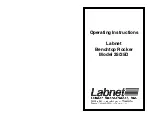
CPC 100
V 3.20
Current Transformer - 3
Use the
CTExcitation
test card to record the excitation curve of a current transformer. This test
performs an automatic injection of a test voltage of up to 2 kV to the current transformer’s
secondary side.
The graph displays the test results in form of an interpolated curve with test point markers.
Turn the handwheel to set the focus onto the graph, and press it. This will bring up a crosshair
cursor that lets you navigate through the list of test points by using the keys
Previous Point
and
Next Point
. Turning the handwheel has the same effect. The fields
V:
and
I:
display the value
pair of each test point.
Noise suppression: Select if you see unsteadiness and jumps in the CT excitation curve. The
unsteadiness or jumps can occur due to noise or disturbance during the measurement.
If noise suppression is selected, the measurement is done with a different frequency.
If f
nom
≥
60 Hz -> f
test
= f
nom
- 10 Hz.
If f
nom
< 60 Hz -> f
test
= f
nom
+ 10 Hz.
The voltage will then be calculated back to f
nom
(V = V
meas
* f
nom
/f
test
). With f
nom
< 60 Hz, the
maximum test voltage is reduced up to 20 % and with f
nom
≥
60 Hz, the maximum test voltage
is increased up to 16 %. The exciting current will not be corrected as the influence is very small.
Demagnetizing the CT Core
Performing a CT Excitation measurement demagnetizes the CT core.
To make the context-dependent menu key
Demag.
visible put the focus onto the test card’s tab.
B
u
rden
CT
DANGER
Do not touch tapped windings.
Maximum test
current
Output frequency
Select to run test
automatically.
Pressing
Add Point
to add a test point to
the graph does not
work in Auto mode.
Actual voltage
Actual current
Maximum test voltage
IEC/BS
According to IEC 60044-1
,
the knee point is defined as the point on the curve
where a voltage increment of 10 % increases the current by 50 %.
ANSI 45°
According to IEEE C57.13
,
the knee point is the point where, with a double
logarithmic representation, the tangent line to the curve forms a 45° angle.
Applies to current transformer cores without an air gap.
ANSI 30°
Like ANSI 45° but forming a 30° angle.
Applies to current transformer cores with an air gap.
Noise
suppression
Demagnetization can also be done without recording an excitation curve by
pressing the button
Demag.
CTExcitation (Knee point)
















































